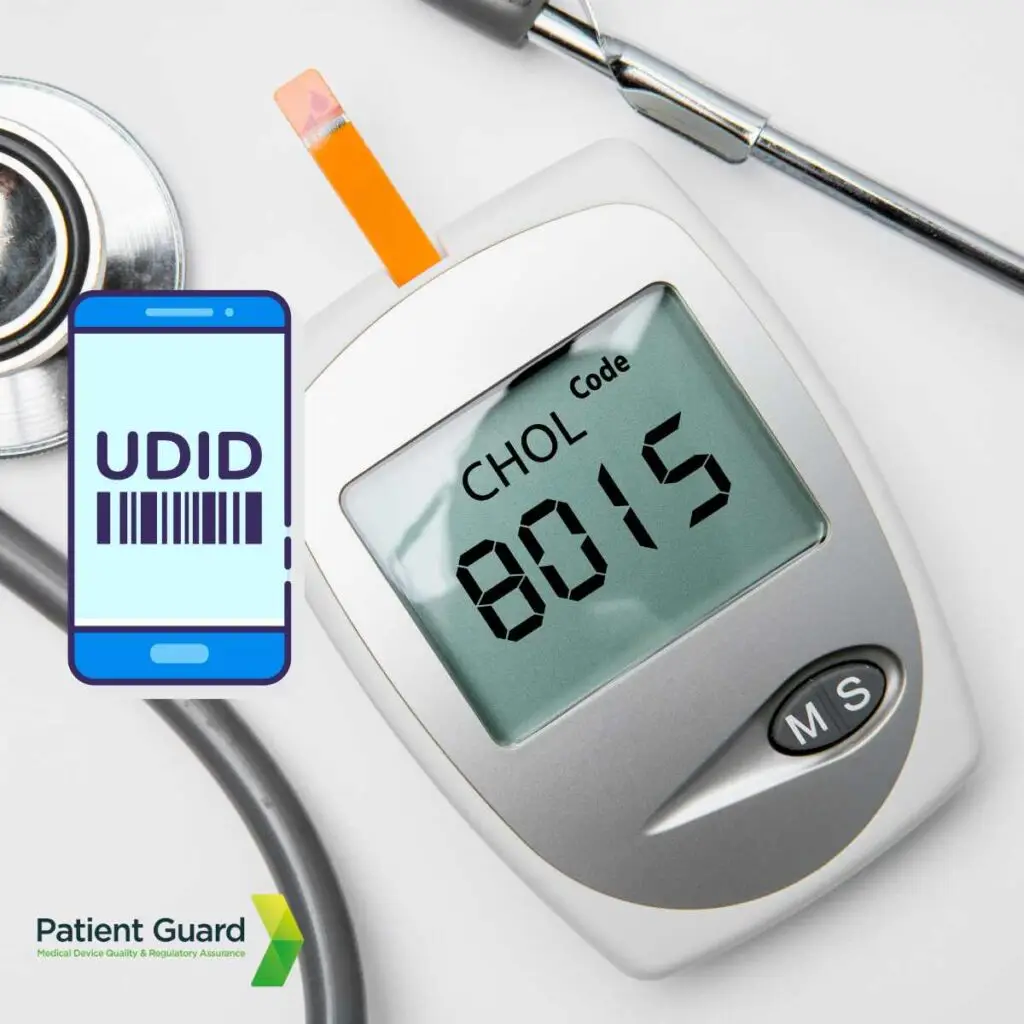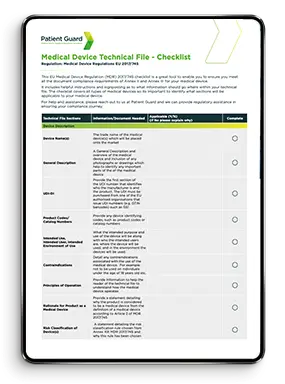What is Medical Device UDI?
Medical Device UDI, or Unique Device Identification, is a system that provides a standardised way to identify medical devices throughout their lifecycle – from manufacturing through to use by healthcare professionals and patients.
A Medical Device UDI consists of two key parts:
UDI-DI (Device Identifier): This is a static, mandatory component that identifies the specific version or model of a device and the manufacturer responsible.
UDI-PI (Production Identifier): This is the dynamic part of the UDI, containing variable information such as lot or batch number, serial number, manufacturing date, or expiry date.
Together, these identifiers ensure that every medical device placed on the market can be individually and uniquely tracked, enabling faster recalls, better traceability, and improved patient safety.

Why Was the UDI System Introduced?
The Medical Device UDI system was developed to improve the safety, traceability, and transparency of medical devices. Several high-profile device recalls and safety concerns over the years have made it clear that rapid access to detailed device information is essential for effective post-market surveillance and public health response.
Key goals of UDI include:
Patient safety: In the event of a malfunction or safety alert, devices can be quickly identified and recalled if necessary.
Counterfeit prevention: UDIs help to verify the authenticity of a product, reducing the risk of counterfeit devices entering the supply chain.
Regulatory efficiency: Regulators can more easily track devices, identify trends, and take action if safety concerns arise.
Supply chain management: Hospitals and clinics benefit from easier inventory control and more accurate recordkeeping.
Global harmonisation: A standardised identification system makes it easier for manufacturers to comply across multiple jurisdictions.
UDI Around the World
While the UDI system is globally recognised, each major market has implemented it in slightly different ways. It’s critical for manufacturers to understand the specific requirements in each region where they market their devices.
European Union: MDR & IVDR
Under the EU Medical Device Regulation (EU MDR 2017/745) and In Vitro Diagnostic Regulation (IVDR 2017/746):
UDI is required for all medical devices and IVDs (with a few exceptions, like custom-made devices).
Manufacturers must assign UDIs to their devices before placing them on the EU market.
The UDI must appear on the device label, packaging, and in some cases, directly on the device.
All UDI-related information must be submitted to EUDAMED, the European database on medical devices.
The UDI-DI is also used in regulatory documents, including the Declaration of Conformity and the Technical Documentation.
It’s important to note that while EUDAMED is still being rolled out in stages, compliance with UDI requirements is already in effect.
United States: FDA UDI Rule
The U.S. FDA requires UDI labelling under the FDA UDI Rule (21 CFR Part 830):
Devices must be labelled with a UDI in both human-readable and machine-readable form (typically a barcode or DataMatrix).
Data must be submitted to the GUDID – the Global Unique Device Identification Database.
Implementation deadlines have varied by device classification, with most devices now required to be fully compliant.
The FDA recognises three issuing agencies for UDI creation: GS1, HIBCC, and ICCBBA.
Other Markets
Countries such as China, Saudi Arabia, South Korea, and Australia have also introduced or are implementing UDI systems. Each market may have unique data elements, timelines, or labelling requirements, so global manufacturers must maintain a flexible and regionally informed UDI strategy.
UDI Structure and Issuing Agencies
UDI-DIs and UDI-PIs are generated using standards set by issuing agencies authorised by regulators. Currently, the most commonly used agencies include:
GS1: Uses GTIN (Global Trade Item Number) as the basis for the UDI-DI.
HIBCC (Health Industry Business Communications Council): Often used by U.S.-based companies, with an alphanumeric structure.
ICCBBA: Primarily used for devices involving human blood, tissue, or cells.
Each agency provides a system for generating and managing UDI codes according to the rules of the relevant authorities.
UDI Labelling Requirements
UDI must be present on the label, outer packaging, and device (if reusable) depending on the type and class of the product.
Human-readable format: Plain text visible to the user.
Machine-readable format: Usually a barcode or 2D DataMatrix that can be scanned by inventory or clinical systems.
Direct marking: For reusable devices intended to be reprocessed, the UDI must be permanently affixed directly to the device.
The labelling format must be clear, durable, and accessible throughout the intended lifecycle of the device.
Data Submission
Once generated, UDI information must be uploaded to the appropriate database:
EUDAMED (EU): Includes UDI-DI, device characteristics, and manufacturer information. As of now, UDI module is operational, although the full database is still being deployed.
GUDID (U.S.): Contains device identifiers and key product information accessible to the public.
Manufacturers should ensure that the data uploaded to these databases is consistent with labelling and technical documentation.
Implementation Challenges
Many manufacturers underestimate the scale of UDI implementation. Key challenges include:
Large product portfolios: Managing UDIs across hundreds or thousands of SKUs can be overwhelming.
Data management: Maintaining accuracy and consistency across multiple databases, systems, and labels requires careful planning.
Changing regulatory timelines: Staying up-to-date with staggered implementation deadlines and evolving requirements can be time-consuming.
System integration: UDI needs to integrate into existing Quality Management Systems (QMS), Enterprise Resource Planning (ERP), and labelling systems.
How to Get Started
If you’re new to UDI, start with the following steps:
Determine your device classifications and confirm whether UDI requirements apply.
Select an issuing agency appropriate for your region and business needs.
Create your UDI-DI and UDI-PI codes according to the agency’s standard.
Update your product labels to include the UDI in both human- and machine-readable formats.
Prepare and upload data to the appropriate database (EUDAMED, GUDID, etc.).
Update your procedures and QMS to reflect UDI activities and responsibilities.
Train your team on the handling, recording, and reporting of UDI information.
How Patient Guard Can Help
At Patient Guard, we provide comprehensive support for medical device and IVD manufacturers at all stages of the UDI journey. Whether you’re working under EU MDR, IVDR, or preparing for UDI compliance in other global markets, our team of regulatory experts can assist you with:
Identifying which UDI rules apply to your product
Choosing and registering with an issuing agency
Developing compliant labelling and data submission strategies
Preparing EUDAMED-ready UDI-DI entries and documentation
Training internal teams and updating QMS procedures
We help reduce the compliance burden so you can focus on what you do best—delivering safe and effective devices to patients.
Frequently Asked Questions (FAQs)
Yes. Under the EU MDR and IVDR, all devices placed or made available on the market must comply with UDI requirements, even if they were previously CE marked under the MDD or IVDD. The compliance timeline depends on the class of the device and any transitional provisions that apply.
Not necessarily. Only components that are individually distributed or used separately may require their own UDI. Kits or systems can have a single UDI-DI for the overall configuration. However, this depends on how the product is marketed and used, so a case-by-case assessment is necessary.
A change in the UDI-DI is considered a significant change that may affect regulatory documentation, including certificates and technical files. If a new UDI-DI is issued, it must be submitted to the appropriate database, and labels and documentation must be updated accordingly.
Non-compliance with UDI obligations can result in regulatory penalties, including product recalls, withdrawal of CE marking, or denial of market access. Authorities may also issue warnings, initiate inspections, or take enforcement actions depending on the severity and region.
Summary
Implementing UDI may seem daunting, especially for small and medium-sized manufacturers. However, with the right planning and expert support, it becomes a powerful system that strengthens compliance, improves patient safety, and facilitates market access.
If you’re just starting your UDI journey—or are unsure whether your current approach is compliant—reach out to Patient Guard. Our experienced team is here to guide you every step of the way.
Resources
- EUDAMED: European Database on Medical Devices
- Understanding Article 10 of EU MDR 2017/745: Manufacturers’ Obligations Explained
- Understanding Article 10 of EU IVDR 2017/746: General Obligations of Manufacturers
- Navigating the EU Medical Device Regulatory Roadmap: A Guide for Manufacturers
- IVDR for Beginners: A Comprehensive Guide for Newcomers
- EU MDR for Beginners: Understanding the Basics of the EU Medical Device Regulation




